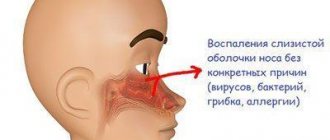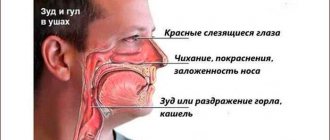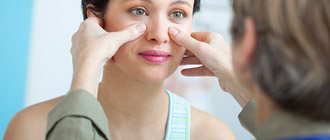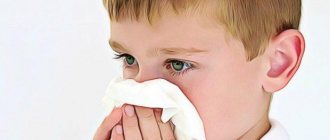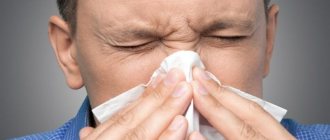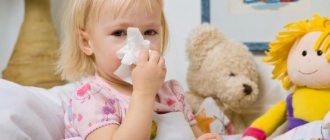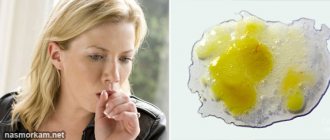Causes
Why does tearing, sneezing and runny nose occur? The mentioned symptoms most often indicate an infectious or allergic lesion of the mucous membranes of the nose and paranasal sinuses. Sneezing and rhinitis are protective reactions of the body, thanks to which pathogenic viruses, microbes and allergens are removed from the respiratory tract. Tearfulness is a consequence of inflammation of the nasolacrimal ducts, leading to disruption of the outflow of fluid from the lacrimal sac.
The absence of temperature during rhinitis and lacrimation in approximately half of the cases indicates the development of an allergic reaction.
Constant sneezing is an alarming symptom that precedes the development of colds. During forced and sharp exhalation, the respiratory tract is cleared of irritating substances - dust, animal hair, gas molecules, viruses, etc. If the first manifestations of the disease are not stopped in time, this will subsequently lead to the development of a runny nose. Inflammation of the mucous membranes stimulates the secretion of nasal mucus, which causes nasal congestion.
Sneezing accompanied by a runny nose without fever
First of all, a runny nose and sneezing, which are not accompanied by a rise in temperature, can be defined as the body’s protective reaction to external irritant allergens. Most often, these symptoms appear in late spring and summer, during the flowering of various plants. A constant runny nose and sneezing in the morning are clear signs of allergies.
However, this is not the only cause of runny nose and sneezing. They may indicate:
- drying out of the mucous membrane;
- non-allergic rhinitis;
- the presence of polyps in the nasal cavity;
- the presence of a foreign body in the nasal passages;
- deviated nasal septum;
- development of respiratory tract infections.
Probable diseases
What diseases cause a runny nose and watery eyes? Most often, nasal congestion, sneezing and watery eyes occur against the background of an infectious lesion of the nasopharynx. The most common diseases leading to the appearance of pathological symptoms include:
- nasopharyngitis;
- allergic rhinitis;
- flu;
- cold;
- sinusitis;
- conjunctivitis;
- hay fever
You can definitely determine the cause of inflammation of the respiratory system after examination by an ENT doctor. Many people do not pay due attention to the process of treating colds, which causes the development of quite serious complications. It should be understood that the progression of the infection is fraught with damage not only to the throat and nose, but also to the paranasal sinuses.
Purulent inflammation of the airways can lead to the development of sinusitis, sphenoiditis, sinusitis and even rhinogenic brain abscess.
Provoking factors can contribute to the development of ARVI, which include:
- hypovitaminosis;
- exacerbation of chronic diseases;
- iron deficiency (anemia);
- hypothermia;
- allergies to food, pollen, medications;
- thermal and chemical burn of the nasopharyngeal mucosa;
- bad habits (smoking, alcohol abuse);
- abuse of antibacterial agents.
In the mucous membranes of the respiratory tract, the infection develops very quickly. That is why delayed treatment of a common cold can lead to dire consequences, including meningitis and pyelonephritis.
Why do my eyes water and runny nose - what to do, how to treat?
A runny nose is not a pleasant condition in itself: the nose is stuffy, it’s difficult to breathe, the discharge requires you to constantly keep a napkin handy... It’s even worse when a runny nose and tears appear at the same time. In this case, the state of health noticeably worsens, and for effective treatment it is necessary to find out what triggered the appearance of both symptoms at once.
Causes of runny nose and watery eyes, when and why do they happen together?
There are several factors influencing the appearance of a runny nose and tearful discharge at the same time. Treatment directly depends on their nature. It is preferable to immediately consult a doctor, who will be able to more accurately determine what provoked these symptoms, and, accordingly, determine how to properly treat tearfulness due to rhinitis in a particular case.
Common reasons
The main reason why tears during a runny nose can bother a sick person is sinusitis. This is due to the close location of the nasal passages and the lacrimal canal.
During the inflammatory process, the nasal septum swells, increases in size, and the passages to the nasal sinuses, accordingly, narrow or close completely. As a result, the passage of mucus becomes more difficult, its volume increases, and it begins to put pressure on the forehead and eye socket.
In the nasolacrimal duct there is only one way for secretions to exit - through the eyes. This is what explains the lacrimation that occurs when you have a runny nose.
So, the secretion of tears during sinusitis is provoked by two aspects:
- increasing the volume of secretions produced;
- swelling of the mucous membrane, narrowing of the nasolacrimal duct.
Diseases
In most cases, the simultaneous flow of tears and snot occurs in the presence of two phenomena: a viral or bacterial infection or an allergic reaction of the body.
In the first case, the situation is dangerous for others, since nasal discharge is an active spreader of the disease.
In the second, when you have a runny nose, your eyes become watery due to increased production of histamine (the body’s reaction to contact with an allergen).
In the absence of adequate and prompt treatment, allergic rhinitis can be accompanied by conjunctivitis, and against the background of deteriorating health, ARVI develops when a secondary infection is added.
What to do, how to treat a runny nose and lacrimation?
Treatment is a two-stage process: it is necessary to remove both the symptoms (nasal congestion and watery eyes) and the root cause of this condition.
It is preferable that treatment be carried out under the supervision of an ENT doctor, since he will be able not only to make an accurate diagnosis, but also to evaluate the success of treatment: each body has an individual reaction to the same drug, therefore, with the same diagnosis, one medicine is effective for some people, for others - different.
How to relieve symptoms?
This is the first thing you need to do to make yourself feel better. It should be remembered that without treating the root cause, the condition can only be temporarily improved, so you should not limit yourself to just relieving symptoms.
First of all, when the eyes are watery from a runny nose, it is important to relieve swelling of the nasal tissues - they are the ones who narrow the nasolacrimal duct and prevent secretions from leaving in the traditional way. To achieve this task, vasoconstrictor drugs such as “Nazivin”, “Otrivin”, “Naphthyzin”, “Rinotays” are used. It is preferable for children to choose the drug in the form of drops, for adults - in the form of a spray.
Reducing inflammation will improve mucus flow and make breathing easier.
But you can use vasoconstrictor drugs for no longer than 4 days: with longer use they can become addictive, and as a result it will be much more difficult to stop using the drug.
As a last resort, if after the specified time without vasoconstrictor drugs the symptoms continue to actively manifest themselves, the medicine is replaced with a similar one, but with a different active substance.
Allergy treatment
If the cause of your snot and watery eyes is an allergy, you should avoid contact with the allergen. This symptomatology is caused by a reaction to external stimuli, such as:
- animal hair;
- plant pollen;
- certain ingredients in food;
- aromas.
Deterioration in health is manifested by sneezing and tearing without fever. In this case, sneezing occurs in attacks - several episodes at a time. The secretion released from the nasal passages is liquid. Congestion may not make breathing difficult, but it still causes discomfort. Swelling and redness in the eye area appears on the face.
Simultaneously with identifying the allergen, in order to stop contacting with it, it is necessary to take antihistamines (Lorano, Zodak, Fenistil) - they reduce the production of histamine, suppress the allergic reaction and restore good health.
Those who have an allergy and are aware of it, before potential contact with an allergen, should take preventive measures to strengthen the immune system, as well as anti-allergy medications - it is easier to prevent the development of a reaction than to eliminate it.
For example, if a reaction occurs to animal fur, and you need to go to a house where these animals are. Or if a reaction to a flowering plant is possible, the body should be prepared before the flowering season. Wearing glasses or contacts is recommended to protect your eyes from lint and pollen.
This will not protect you from an allergic reaction completely, but it will definitely reduce its intensity.
Treatment for conjunctivitis
There are two types of inflammation of the eye mucosa - conjunctivitis: unilateral or bilateral. The first type is more common - in this case, only one tear duct is clogged, so tear production occurs, accordingly, only from one eye. At the same time, nasal congestion (a runny nose in this case is bacterial) and normal body temperature remain.
Treatment of conjunctivitis in children is carried out exclusively under the supervision of a doctor, while adults can limit themselves to the use of antiviral, antibacterial drops of local action - “Ophthalmoferon”, “Torbex”, “Okomistin”. Don’t forget about vasoconstrictor medications to reduce nasal swelling.
Treatment for ARVI
If the cause of a runny nose and watery eyes is a viral infection, the first thing you should do is limit your contact with family members, since this disease is contagious and spreads through secretions (including sneezing).
ARVI is accompanied by fever and sometimes pain in the throat and head. The symptoms immediately appear very intensely, so you should not hesitate with treatment.
When your eyes water from a runny nose, in addition to the use of vasoconstrictor medications, you must adhere to the following recommendations:
- take antiviral drugs (Coldrex, Theraflu, Antigrippin);
- take antipyretics (“Nurofen”, “Ibuprofen”, “Ibuklin”, “Tylenol”);
- gargle with furatsilin solution, use drugs such as Givalex, Orasept;
- drink water in an amount of at least 1.5 liters per day;
- strengthen the immune system with vitamin complexes;
- carry out wet cleaning of the room;
- ventilate the premises.
If ARVI is accompanied by a secondary virus or bacterial infection, it is necessary to supplement the arsenal of medications with antibiotics, and after completing their course - with bifidobacteria to restore the intestinal microflora, which is negatively affected by antibiotics.
Folk remedies that will remove runny nose and lacrimation
You can remove swelling of the nasal mucosa by rinsing it with the following means:
- Saline solution - 1 tsp per 300 ml of water. salt, stir thoroughly.
- Soda solution - 1 tsp per 300 ml of water. baking soda, stir until dissolved.
Washing is carried out 2-3 times daily. When the swelling of the mucous membrane decreases, tear production will immediately decrease.
Other folk remedies will also help with tears during a runny nose and with the runny nose itself.
Chamomile decoction
1 tbsp. A spoonful of dried flowers is poured into 300 ml of cold water and heated to a boil. After boiling, keep on fire for 3-5 minutes, remove from it and cool. In the strained broth, you can moisten cotton pads and apply them to your eyes to reduce tear production. If you take the decoction internally, it will relieve inflammation and will be an effective remedy for runny nose and sneezing.
Calendula decoction
1 tbsp. pour 300 ml of boiling water over a spoonful of dried flowers, leave for a quarter of an hour and filter. Used for washing mucous membranes - nasal passages and eyes.
Cornflower flowers for conjunctivitis
1 tbsp. pour a glass of boiling water over a spoonful of dried flowers, cover and leave for 1-2 hours. Strain the liquid and use it to wet tampons, which are then applied to the eyelids for 10-15 minutes twice a day.
Principles of treatment
How to treat if your eyes water when you have a runny nose? As already mentioned, lacrimation in most cases occurs due to inflammation of the nasolacrimal duct. With adequate treatment, the outflow of tear fluid is normalized, thereby eliminating unwanted manifestations of the disease.
As a rule, treatment begins with taking medications that eliminate the direct cause of rhinitis - infection. For a cold, pathogenic flora in the nasopharynx can be destroyed using antiviral agents: Anaferon, Groprinosin, Ingavirin, Lavomax, Arbidol, etc. In addition, it is recommended to use symptomatic medications, which can stop coughing, sneezing, lacrimation and rhinitis.
You can speed up the process of clearing the respiratory tract from infection with the help of sanitizing procedures and inhalations. Irrigation of the nasopharynx with anti-edematous and wound-healing medications can quickly ease nasal breathing and reduce the severity of inflammation in the mucous membrane. In case of allergic damage to the ENT organs, it is possible to relieve the symptoms of the disease with the help of systemic and local antihistamines.
Antiallergic drugs
What should you do if your eyes water when you have a runny nose? The combination of symptoms often indicates the development of allergic rhinitis. If an irritating substance (allergen) penetrates the respiratory system, this leads to inflammation of the mucous membranes. It is worth noting that the patient’s general well-being is practically not affected - there is no temperature, body aches or sore throat.
Allergic rhinitis is not a harmless disease, as it can lead to inflammation of the auditory tube and, as a consequence, the development of otitis media. If your eyes begin to water, and your nose begins to itch or burn, you should seek help from an immunologist or allergist. The following antihistamines can be used to relieve allergic manifestations:
- "Hifenadine";
- "Cetrin";
- "Loratadine";
- "Astemizole";
- "Trekhsol."
Modern antiallergic drugs affect the mechanisms of development of edema in the mucous membrane of the nasopharynx and nasolacrimal duct. Therefore, with timely use of medications, after a couple of days, patients’ rhinitis disappears and lacrimation stops.
Aerosol inhalation is one of the most effective physiotherapeutic procedures, thanks to which it is possible to quickly eliminate almost all local manifestations of a cold - nasal congestion, sneezing, coughing, sore throat, etc. Unlike oral tablets, the aerosol penetrates directly into the lesions. Due to this, the concentration of antimicrobial, antiviral and anti-inflammatory substances quickly increases in inflamed tissues.
In order for the nose to stop stuffy, you need to eliminate inflammation and swelling in the mucous membrane. For these purposes, drugs with anti-edematous, immunostimulating, antibacterial and antiviral effects can be used:
- "Interferon";
- "Tonsilgon";
- "Chlorophyllipt";
- "Rotokan";
- "Furacilin".
To increase the effectiveness of nebulizer therapy, before inhalation it is recommended to drip vasoconstrictor drops into the nose - “Rinza”, “Galazolin”, “Naphthyzin”, etc.
Remedies for stuffy nose
Nasal congestion occurs when the nasal membrane becomes inflamed as a result of infections and irritants.
Steam
Steam inhalation effectively dilutes nasal mucus and flushes out infections and irritants responsible for symptoms. Steam is also good for moisturizing the nasal cavities.
Option #1 is to take a hot bath or shower for 10 to 15 minutes. Option number 2 - lean over a container of hot water and deeply inhale the steam. Inhalations should be done at least twice a day, preferably in the morning and evening.
Keep the air humid and ventilate the room throughout the day to prevent mold from growing as a result of elevated humidity levels.
Get rid of potential allergens and irritants
When present in your environment, allergens such as pet dander, pollen, dust mites and mold can cause allergic reactions leading to nasal congestion as well as a runny nose. The same applies to irritants such as paints, strong odors, chemical fumes, etc.
Try to identify any such substances and remove them from your environment.
Sanitation of the nasopharynx
How to treat a stuffy nose and watery eyes? Nasal drops help eliminate inflammation in the nasal cavity, but they have virtually no effect on the condition of the mucous membrane in the paranasal sinuses. To ensure that mucus and infectious agents contained in it are washed out of the nasopharynx and paranasal sinuses, it is recommended to carry out sanitizing procedures.
Rinsing the nose with saline solutions helps normalize the outflow of intercellular fluid from the lesions. In addition, preparations based on sea salt have a beneficial effect on the condition of the mucous membrane, accelerate its regeneration and increase local immunity. Sanitation procedures are recommended for the development of a runny nose of any etiology. Anti-inflammatory and antiseptic agents destroy pathogenic agents in the ENT organs and thereby accelerate recovery.
Important! You should not tilt your head back while rinsing your nose, as the liquid can penetrate the auditory tube and cause inflammation in it.
To rinse the nasopharynx the following can be used:
- “Physiomer” is a solution based on sea salt, has an anti-edematous and wound-healing effect;
- "Quix" is a mucolytic agent that helps to liquefy and remove mucus from the paranasal sinuses and nasal passages;
- "Dolphin" is an isotonic solution based on sea salt, which accelerates the healing process of the nasopharyngeal mucosa.
Sanitation of the nose should be carried out at least 3-4 times a day during exacerbation of respiratory diseases. Regular rinsing of the nasopharynx and irrigation of the mucous membrane can eliminate a severe runny nose within a few days.
People don't always cough and sneeze because of the flu.
Our doctor wrote about both colds and flu. Next, everything is serious. And the continuation of the poem is at the end of the articles:) Cold.
Runny nose, sneezing, cough. Flu or cold? The common cold (acute respiratory viral disease, viral nasopharyngitis, etc.) is a contagious viral disease of the upper respiratory tract. The most common causes of ARVI are rhinoviruses, picornoviruses and coronaviruses.
A cold does NOT develop from hypothermia, i.e. Hypothermia is not the primary cause of colds, despite popular belief, but hypothermia can temporarily suppress the immune system (not yet clearly proven) and contribute to the development of infection.
Colds are more common during the cold season (from September to April). The common cold is the most common infectious disease in humans. Influenza is an acute respiratory disease caused by the influenza virus. Flu and colds are often difficult to distinguish from each other (even for doctors), because... the symptoms are similar, although the flu is usually more severe. Treatment of flu and colds (in all cases except severe ones) is almost identical - drink plenty of fluids, bed rest, heat, lowering the temperature.
Cold symptoms
The most common symptoms of a cold are coughing, sneezing, sore throat, runny nose, nasal congestion, and fever. Less common are redness of the eyes, muscle pain, weakness, headaches, and chills. The combination of two symptoms - cough and fever - usually speaks in favor of the flu rather than a cold with a probability of 80%.
The severity of symptoms is more pronounced in young children, smokers and elderly patients (due to the relative weakness of the immune system in these categories of patients). The duration of symptoms is about a week, in some cases, unfortunately, longer - up to four weeks. Complications of a cold
Colds can lead to the development of opportunistic infections and superinfections, for example, to the development of bronchitis, bronchiolitis, croup, pneumonia, sinusitis, otitis media, etc. Patients with pre-existing diseases, for example, with chronic lung diseases (asthma, chronic bronchitis) are especially susceptible to developing complications .
Viruses that cause colds In 30-50% of cases, colds are caused by rhinoviruses. In 10-15% of cases, the cause of colds is coronaviruses. Less common are parainfluenza viruses, respiratory syncytial virus, adenoviruses, enteroviruses, and metapneumovirus. In total, colds can be caused by 200 different types of viruses. Because of this diversity of viruses and the tendency of viruses to mutate, it is impossible to develop immunity to the common cold.
What else is important
The role of hypothermia has already been discussed above. It is also known that lack of sleep can contribute to the development of a cold. People who sleep less than 7 hours a night are 3 times more likely to get a cold when exposed to coronavirus than those who sleep more than 8 hours. Low vitamin D levels are a risk factor for developing colds
Incubation period and development of colds The virus begins to multiply 8-12 hours after infection. Symptoms usually begin to develop 2-5 days after infection, sometimes faster - from 10 hours. Cold symptoms reach their maximum development 2-3 days after the onset of clinical manifestations (and with the flu, symptoms immediately reach their maximum development).
A cold, as already mentioned, lasts 7-10 days, sometimes the illness drags on for up to four weeks. Cold prevention
The best way to prevent a cold is to wash your hands thoroughly.
With this simple manipulation it is possible to reduce the incidence of colds by 20%. Probiotics are effective in children 3-5 years old. It has not been possible to develop a vaccine to prevent the common cold (an effective flu vaccine exists). Treatment of colds
Treatment of colds is symptomatic. This means that treatment for a cold is aimed at relieving symptoms rather than speeding up recovery. 1. For a cold, medications are prescribed to reduce the temperature - most often paracetamol or one of the drugs from the group of non-steroidal anti-inflammatory drugs (for example, ibuprofen). Combination drugs (for example, Hotrem or Fervex) are no more effective than conventional anti-inflammatory drugs and are not recommended for children due to side effects. Drink plenty of fluids to avoid dehydration. Bed rest Gargling with warm saline solution. For a runny nose, use vasoconstrictor drops and saline solutions in nasal drops.
Antibiotics and antiviral drugs Regular antibiotics do not work against the viruses that cause colds. Antiviral drugs are not used for colds.
Alternative Treatment Methods The use of echinacea, calendula, and garlic is not effective. Vitamin C in normal or higher doses may only be useful in people who develop a cold during intense physical activity or after exposure to extremely cold temperatures.
Forecast
The prognosis for colds is excellent, the vast majority of patients recover.
https://drloginov.ru/ Runny nose, sneezing, cough. Flu or cold?
Are you worried about a cough, runny nose, sneezing, or feeling unwell? You should try to determine whether it is the flu or a common cold.
Influenza, more often than a cold, leads to the development of complications in the elderly, children and weakened patients with concomitant diseases. Treatment of many complications requires hospitalization. The most common among them are pneumonia (pneumonia), bronchitis, sinusitis (inflammation of the paranasal sinuses) and otitis media (most often otitis media).
So, how can you tell if it's the flu or a cold?
Start by measuring your body temperature. For most adults, a cold is accompanied by a slight increase in temperature. If you have a fever above 38?C, you almost certainly have the flu.
The flu usually manifests itself with a set of symptoms: severe headache, intense muscle pain throughout the body, and malaise lasting several days. A dry cough and sore throat are usually worse with the flu.
During a cold, on the contrary, nasal congestion and sneezing usually predominate. Headaches and muscle pain are much less of a concern. Weakness during a cold is not as severe as during the flu. Unlike the flu, cold symptoms usually develop slowly and disappear within 5-7 days.
When to see a doctor
It's best to see your doctor before you get sick for a seasonal flu vaccination. However, if you did not have time to get vaccinated against the flu and you yourself get sick or there is a sick person in your family, you should consult a doctor. Antiviral medications prescribed within 48 hours of the onset of illness or contact with a sick person can help prevent the flu or reduce symptoms.
Seek immediate medical attention if symptoms occur
difficulty breathing or chest pain
persistent high fever
severe headache
· uncontrollable vomiting
cough lasting more than 2 weeks
Headache and nasal congestion for more than 2 weeks
All of these symptoms may indicate serious complications and require evaluation by one of our doctors.
Of course, you can on our forum. We will certainly try to answer you as soon as possible.
Loginov PV, European Medical Center
Continuation of the poem FLU
I look sad - My head hurts, I'm sneezing, I'm hoarse. What's happened? This is the flu. Not a ruddy mushroom in the forest, But a nasty flu in the nose! In five minutes they stripped me, everyone around me began to feel sorry for me. I'm lying in my bed - I'm supposed to be sick.
The temperature has risen, I lie and do not complain - I drink a salty mixture, I gargle with sour.
They put mustard plaster on my chest, They say: “Be patient, excellent student!” After the cans on the sides Leather in blue nickels.
Antoshka the cat jumped from the window onto the bed in one leap. - Do you want me, Antoshka, to fill your nose with powder?
Antoshka the cat arched his back and purred in response to me: “Shall we resort to penicillin? To me? To the cat? Since such and such years?!
I don’t object to the cat - It’s useless to object, I’m lying there, wondering, How long do I have to lie there?
I lie down for a day, I lie down for the second, I don’t go to school for the third. And they don’t let friends in, They say I’ll infect them!..
Eh, I wish I could get up now and enter the fourth grade: “Zoya Pavlovna, answer, What’s new with you? Zoya Pavlovna, answer!..” Zoya Pavlovna is silent...
I'm flying to Mars in a rocket... A bear is growling at me...
How are you, restless? How is your health? Are you sleeping, patient? This is the treating, district Doctor bending over me.
A runny nose and sneezing can be accompanied by a variety of diseases, both colds and allergies. Therapeutic tactics are determined depending on the type of provoking factor. To correctly determine the cause of the disease, you need to consult a specialist. A runny nose and sneezing without fever are often signs of a cold.
Nasal discharge and sneezing are also noted:
- with prolonged use of a spray or nasal drops with a vasoconstrictor effect, dryness of the nasal mucosa may occur. It is accompanied by itching and crusts in the nasal cavities. Damage to small vessels and the release of blood streaks is also possible;
- Vasomotor rhinitis is a consequence of sudden temperature changes, hypothermia, inhalation of polluted air, fluctuations in hormonal levels or dysfunction of the autonomic nervous system. As a result of this, the nasal mucosa inadequately responds to the action of internal or external factors, which is manifested by hypersecretion and swelling;
- Rhinovirus infection often manifests itself as profuse rhinorrhea, lacrimation, redness of the conjunctiva and nasal congestion. If a person’s immunity is strong enough, the infection occurs without fever. Low-grade hyperthermia can be recorded against a background of weakened immunity or severe concomitant pathology;
- polypous formations in the nasal cavities, irritating the mucous membrane;
- allergic reactions, which are characterized by lacrimation, itching of the skin, eyes, conjunctival hyperemia, cough, skin rashes, difficulty breathing and rhinorrhea.
To distinguish allergies from other diseases, it is enough to know its symptoms. Usually they are:
- appear suddenly (immediately after contact with the allergen);
- have a seasonality if the provoking factor is pollen or fluff;
- manifested by watery nasal discharge.
In some cases, to confirm the allergic origin of a runny nose, it is enough to take an antihistamine, after which it becomes much easier to breathe.
Causes of tearing
In fact, tearing of the eyes is a natural protective reaction of the body. The eyes are moisturized, which ensures:
- replenishment of the cornea;
- getting rid of pathogenic bacteria and dust particles.
Thanks to the lacrimal glands located in the corners of the eye sockets, fluid can flow to the eyeball and then be evenly distributed throughout it. The fluid accumulates in the inner recess of the eye slits, which is called the ocular lacrimal lake. After this, the tears enter the nasal cavity.
If tears flow for no apparent reason, and itching in the eyes does not go away, health problems should be suspected.
There are many reasons for lacrimation. The most common of them will be:
- active inflammation of the nasal mucosa and paranasal sinuses (sinusitis);
- inflammatory process caused by allergens (allergic rhinitis, expressed by hay fever or an allergic reaction to irritants);
- active inflammation of the eye membrane, provoked by viruses, infection, allergies (conjunctivitis).
Children and middle-aged people are especially susceptible to these diseases. Only a doctor can tell why problems appeared in the nose and eyes of a particular patient.
The main recommendation for those who have watery eyes and a runny nose is to try not to create excessive pressure in the nose. When blowing your nose, do not pinch both nostrils at once.
Otherwise, the infection from the nose will spread further, aggravating the situation.
Very often, patients are affected by sinusitis. The obvious symptoms of the disease are: swollen, stuffy nose, sneezing, coughing. When you have a runny nose, your eyes constantly water and your snot becomes clear. This symptom is accompanied by itching and pain in the nasopharynx and throat.
The internal pathological process is caused by drying out of the septum, causing abundant secretion of sputum and difficulty breathing. The nasal septum increases in size, blocking the entrance to the paranasal sinuses. As a result:
- the patient's general condition worsens;
- headaches and sneezing begin;
- suffer from discomfort in the cheekbones and eye sockets.
During acute respiratory viral infections or acute respiratory infections, the eyes become watery due to swelling of the nasolacrimal duct. If the nose is stuffy, all the exudate accumulated in the nasopharynx comes out through the lacrimal canal, which is unnatural.
Sinusitis is easy to treat. If it is started, the disease becomes chronic. This has a detrimental effect on the organs of vision: the eyes itch and become red. Therefore, the doctor will prescribe antibacterial nasal drops to dilate blood vessels. They contain antibiotics belonging to the group of penicillins and cephalosporins.
Dry cough with sinusitis can be eliminated if:
- gargle with decoctions of medicinal plants (if there are no allergies);
- dissolve tablets with a certain spectrum of effects.
Popular medications of this type include Naphthyzin. However, despite their high efficiency, there is no need to use drops for longer than 3-5 days. If this is not taken into account, the body will get used to the medicine, and soon the drops themselves will cause nasal congestion and swelling of the mucous membrane. The drops stop helping, the snot does not go away.
The duration of the course of treatment directly depends on the condition of the body and is determined by the doctor on a strictly individual basis.
Drug treatment
To eliminate the symptoms of a disease, you need to know its cause. The range of prescribed medications depends on this:
- vasoconstrictor drops or nasal sprays are symptomatic treatment aimed at reducing swelling and hypersecretion of the mucous membrane. The action of drugs is based on reducing the diameter of blood vessels at the site of their administration. Medicines provide a temporary improvement in nasal breathing, after which congestion and rhinorrhea return again. The duration of the effect depends on the composition of the drops and can be 5-12 hours. The course of using drugs should not exceed 5 days, otherwise the risk of addiction increases. If further use of vasoconstrictor drugs is necessary, drugs with different compositions must be used. To ease breathing, Tizin, Evkazolin, Nazivin or Otrivin are prescribed;
- rhinitis requires regular rinsing of the nasal cavities with saline solutions. This makes it possible to clean the mucous membrane from crusts, dust particles, mucous discharge and allergens. Thus, the severity of inflammation decreases and regenerative processes are activated. Washing should be done before using medicinal drops. This allows you to achieve maximum effect from treatment;
- drops with antibacterial action. Prescribing such medications is advisable after receiving culture results that confirm the presence of bacterial pathogens. In the treatment of adults, medications such as Bioparox or Polydexa can be used;
- IRS-19 and Derinat are immunomodulators that increase the protection of the mucosa from the penetration of infectious microorganisms. The effect of use develops after a few weeks.
If they appear in response to an allergen, specific treatment is required. It implies:
- oral administration of antihistamines - Suprastin, Diazolin, Erius;
- local use of antiallergic drugs - Zyrtec, Fenistil;
- prevention of contact with an allergen;
- Prescribing hormonal drugs is advisable in severe cases of the disease, if antihistamines cannot cope with allergies. Nasal drops that contain a hormonal component are addictive. These medications include Nasonex and Avamis.
An integrated approach to the treatment of allergies allows you to block the release of mediators that support the course of the allergic reaction. As a result, the severity of symptoms decreases and the general condition improves.
In the case of seasonal allergies, a person must prepare in advance for contact with the allergen (medicines, protective equipment) or change their place of residence.
Help with folk remedies
Colds and allergies will go away much faster if drug therapy is supplemented with folk remedies. The following solutions can be used to rinse the nose:
- lemon juice;
- onion or garlic juice, diluted with water 1:1 and 1:2.
Do not forget about inhalations, in which vapors must be inhaled through the nose.
Folk remedies can have a good effect at the initial stage of the disease, when only sneezing and slight rhinorrhea are a concern. Subsequently, prescription of medications is required. This is necessary to prevent the spread of inflammation and the development of complications. Equally important in treatment is drinking plenty of warm drinks, limiting physical activity and contact with sick people.
What should I do if my nose is running and I'm sneezing? Hundreds of people ask their doctor this question every day, since a runny nose only brings unpleasant experiences. Symptoms of rhinitis can be very painful, and it is not known what causes more suffering - dryness and burning at the beginning of the disease or obsessive sneezing combined with heavy discharge that appears later. If the nose is literally running, it is difficult for a person to concentrate on everyday tasks, and he has to carry a handkerchief with him everywhere. In addition, runny nose, or rhinorrhea, is not accompanied by relief from nasal breathing - it can continue for a long time due to swelling and only gets worse with sneezing. How to cope with annoying symptoms?
Basic Rules
Sneezing and runny nose are the most common symptoms of a cold. But even in the same person at different times they can characterize other diseases - for example, allergic or vasomotor rhinitis. Therefore, when choosing treatment, you should adhere to the following rules:
- Make sure the diagnosis is correct.
A runny nose and sneezing are not specific, that is, signs inherent only in one specific pathology. They appear in various pathological processes, which requires clarification of the cause and individual selection of therapy. Only a specialist can make an accurate diagnosis.
- Influence the cause of the runny nose if possible.
Colds are treated symptomatically, but for allergic rhinitis, the treatment regimen includes various drugs to relieve not only the symptoms, but also the mechanisms of development of the allergic reaction, the use of which at the onset of the disease significantly alleviates the patient’s condition.
- Do not neglect non-medicinal methods.
Treatment of a runny nose is not only about suppressing sneezing and reducing the volume of discharge with the help of pharmacological drugs. It is also necessary to pay attention to microclimate parameters and diet.
If you have a runny nose and persistent sneezing, avoid using irritating medications, including home remedies, as they may make symptoms worse.
You should not treat a runny nose with heavy discharge and sneezing with onion or garlic juice, as well as aloe or Kalanchoe juice. It is better to avoid contact with spices, tobacco smoke, and various chemicals (including household chemicals). This is especially important if the symptoms appeared suddenly, since in this case there is a high probability that the patient has an allergy.
A severe runny nose significantly reduces the patient’s quality of life, so treatment should be started without delay, without waiting for the condition to worsen. It should be understood that even with active therapy, signs of rhinitis will only be completely eliminated after a few days.
It tickles your nose and hurts your eyes
ContentsIrritating odorsDry noseVirusesAllergiesNasal polypsMigrainesCPAP for the treatment of apnea
A considerable number of people sincerely believe that if your right nostril itches, expect joyful events and gifts, or, suddenly, the birth of a girl in the family. If on the left - troubles and financial losses, or for some reason the birth of a boy. Doctors are skeptical about predictions that the sex of an unborn child is determined solely by the tickle area in the nose. According to doctors, there are very real explanations for itching in the nasal cavity.
MedAboutMe found out what causes a ticklish nose and when you should see a doctor about it.
Irritating odors
There are unpleasant smells, and there are smells that simply irritate the nasal mucosa. Smoke (from a fire or from cigarettes), as well as various household chemicals, have the same effect - these are common irritants that cause discomfort to any person. There are also individual preferences - some people cannot tolerate the aromas of certain types of perfumes, etc.
Non-drug methods
In most cases, treatment of a runny nose is carried out at home, according to the recommendations of the attending physician. Non-drug methods are used for all types of rhinitis and are designed to create the most comfortable conditions to speed up recovery and reduce the risk of complications. These include:
- maintaining temperature and humidity at 19-22 °C and 50-70%, respectively;
- regular ventilation of the room in which the patient is located (in his absence);
- systematic wet dust removal, elimination of “dust accumulators” - carpets, soft toys;
- quitting smoking (including passive smoking, near a smoker), alcoholic beverages;
- refusal of spicy, fried, fatty foods, in case of allergies - a hypoallergenic diet;
- drinking a sufficient daily volume of liquid (water, tea, fruit juice).
For vasomotor rhinitis, it is advisable to avoid sudden changes in temperature and air humidity, as this can provoke an exacerbation. A patient who suffers from a runny nose should get enough sleep and, if possible, avoid physical exertion and emotional shocks. If a runny nose is a symptom of a cold, it is accompanied by weakness, general intoxication, and fever - in this condition, long rest is indicated; when the body temperature rises, bed rest is indicated.
Irrigation therapy
Irrigation therapy refers to methods aimed at cleansing the nasal cavity of pathological secretions. A runny nose sometimes lasts for a long time - while the use of pharmacological drugs is limited due to the adverse effects on the nasal mucosa and the body as a whole. Nasal rinsing can act as a safe alternative to vasoconstrictor drops because it can:
- facilitate nasal breathing;
- eliminate secretions and crusts accumulated in the nose;
- mechanically remove allergens, infectious agents, irritants.
Treatment with lavage of the nasal cavity helps to cope with both acute and chronic runny nose of various etiologies. The method is indicated, among other things, for allergic rhinitis. In addition, clearing the nose of mucus is a necessary measure before administering medications (for example, topical glucocorticosteroids, antibiotics, antiseptics). The advantage of washing is that it can be done at home. You need to repeat the procedure several times a day.
The best solution for rinsing if the nose is running and sneezing is annoying is considered to be a 0.9% sodium chloride solution - saline solution.
Saline solution can be found in any pharmacy, it is already prepared for use, sterile, and is offered in different volumes (100, 200 ml or more). The product does not irritate the mucous membrane, but at the same time moisturizes and effectively cleanses it. Currently, preparations based on sea water are also quite popular - for example, in the form of sprays, nasal drops (Aqua Maris, Humer).
Sneezing and runny nose combined with itchy nose
If symptoms such as sneezing and runny nose without fever, as well as itching in the nose appear, then the following factors may be the cause:
- The presence of infections of a viral or bacterial nature. In this case, snot flows due to the increased formation of mucus in the nasal cavity, which is a response to the introduction of viruses. An itchy nose, like sneezing, is the result of irritation of the receptors in the mucous membrane. You should not ignore these symptoms and assume that it will go away over time, because the upper respiratory tract is often affected by such complex bacteria as meningococci, staphylococci, streptococci. It is advisable to consult a doctor and do the necessary tests;
- Both benign and malignant neoplasms in the nasal cavity - cysts, papillomas;
- The effect of chemicals or physical irritants on the nasal mucosa. In especially severe cases, there may even be a chemical burn, the reaction to which is the flow of mucus and severe itching.
Pharmacological drugs
How to treat sneezing and runny nose? The goal of therapy is:
- Facilitation of nasal breathing.
- Eliminate swelling, dryness, reduce the amount of discharge.
- Restoration of damaged mucous membrane.
Colds, ARVI
Treatment of a runny nose during colds and acute respiratory viral infections includes vasoconstrictor drops, sprays (decongestants) that improve nasal breathing by eliminating swelling and reducing the activity of rhinorrhea. Decongestants (Xylometazoline) are injected into the nasal cavity several times a day and used for no longer than 5 days. Medicines based on eucalyptus, mint, and pine oils (Pinosol) have an anti-inflammatory and antiseptic effect.
For viral rhinitis at the onset of the disease, drugs containing interferon (Grippferon) may be useful. They are both antiviral agents and immunomodulators, helping to fight inflammation. However, combined use with decongestants is unacceptable; confidence in the viral etiology of the disease is necessary (colds are often caused by bacteria that constantly live in the nasopharynx and are activated by hypothermia).
Allergic rhinitis
In the treatment of the disease the following is used:
- decongestants (Otrivin);
- topical glucocorticosteroids (Nasonex);
- antihistamines, cromones (Cetrin, Ketotifen);
- intranasal anticholinergics (Ipratropium bromide);
- leukotriene receptor antagonists (Montelukast).
To quickly eliminate a runny nose and sneezing, the main symptoms of allergic rhinitis, decongestants and antihistamines are used. The remaining medications are intended for long-term therapy and prevention of exacerbations.
It is worth knowing that decongestants do not treat inflammation due to infection or allergies, they only temporarily eliminate rhinorrhea and belong to symptomatic drugs.
Vasomotor rhinitis
Intranasal anticholinergics and topical glucocorticosteroids help relieve sneezing and runny nose in this disease. A topical antihistamine, Azelastine, can also be used.
It is necessary to treat a runny nose under the supervision of a doctor, since nasal discharge in combination with sneezing is often caused not by a cold, but by rhinitis of an allergic nature. Whatever the reason for the appearance of symptoms, they cannot be ignored, otherwise complications may develop. A general practitioner or otolaryngologist (ENT doctor) can help with rhinorrhea and sneezing.
Traditional recipes for runny nose and sneezing
A runny nose accompanied by sneezing can be caused by a variety of conditions, including allergies, colds, and nasal irritation. Garlic and ginger cope very well with these symptoms.
Garlic
Garlic has antiseptic and antibacterial properties, so it is an indispensable remedy in the fight against sneezing and runny nose. It can be used internally and externally.
You need to crush 3 cloves of garlic to a paste and inhale the aroma deeply. This helps clear the nasal passages and relieve sneezing and runny nose. After this simple procedure, breathing becomes much easier.
It is also worth adding garlic to any dishes throughout the day.
Cut 3 cloves of garlic and cook them in a glass of water for 3-5 minutes. Strain the broth and add sugar, it tasted better. Drink twice a day.
Eat a small clove of garlic three times a day.
Ginger
Ginger has anti-inflammatory and antiviral properties.
Can be consumed raw or as ginger tea several times a day. To prepare it, place small slices of ginger in hot water and let it steep for a few minutes, then add a teaspoon of honey. Instead of honey, you can add a couple of tablespoons of lemon juice.
Mix a teaspoon each of dry ginger powder, sugar, and ghee. Take the mixture once a day on an empty stomach.
Take a small piece of ginger (raw) sprinkled with salt and consume several times a day.
Make a paste of ginger, garlic and then take ½ spoon of the mixture sprinkled with a pinch of salt twice a day.
